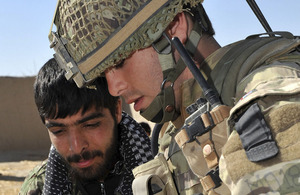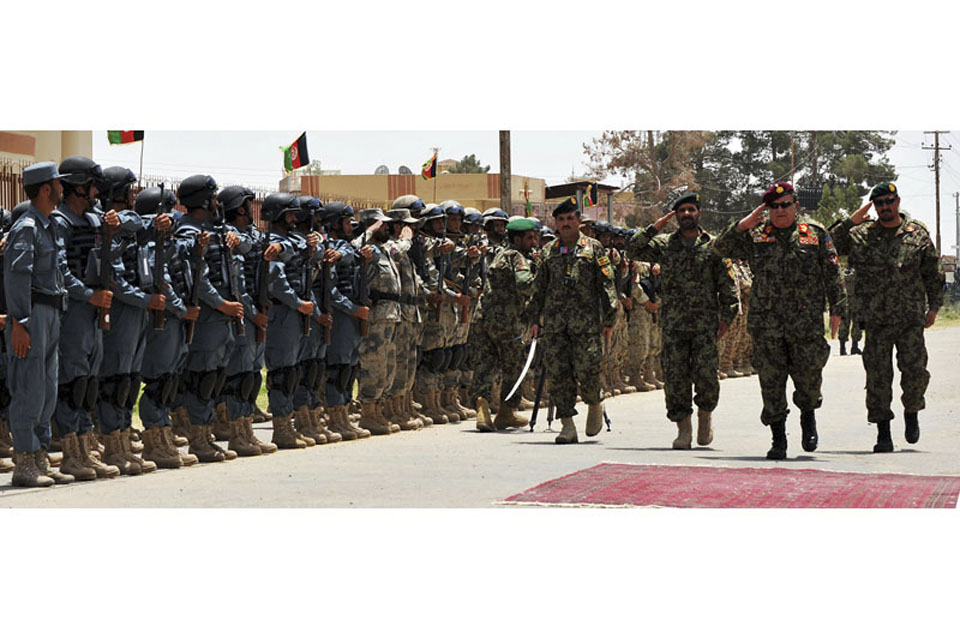Transition in Afghanistan explained
With 50 per cent of the Afghan population living in areas of transition, it's all change. But what exactly is 'transition'?

A British soldier from 2nd Battalion The Parachute Regiment and a member of the Afghan National Army plot a patrol route in northern Nad 'Ali (stock image) [Picture: Sergeant Rupert Frere, Crown Copyright/MOD 2011]
Look up “transition” in the Oxford English Dictionary and it will define it as “a passing from one place, state or condition to another”. That seems fair enough, but like many things in Afghanistan, when applied to the transfer of responsibility for security, the definition is not quite so straightforward; which is why Brigadier Tim Bevis has spent 12 months in Kabul as Director of the ISAF Transition and Assessment Group developing and refining “what we mean by transition”.
The ISAF brief describes transition as a Joint Afghan NATO Inteqal (the Dari and Pashtu word for Transition) Board, ultimately resulting in the Afghan National Security Forces (ANSF) taking responsibility for security. It also makes clear that transition is a lengthy process, not an event. And although working towards a full ANSF lead is not time-conditional, 31 December 2014 is concentrating the mind:
Our model of transition,” says Brigadier Bevis, “is security with a big S, governance with a reasonable-sized G and development with a small D - development is a slower burn over a longer time frame.
The problem is - well, one of the problems is - each geographical area has a different starting point, and maybe a different end point, and a different journey to get there.
At the beginning of his tour the Brigadier became familiar with the typical view from the ground when assessing whether an area was ready, which was, he says:
‘Well it’s not perfect, so I’m not ready to transition just yet’. Which, if you are not careful, can become a continuous roll to the right.
Happily, this was balanced by a strategic view which was, if you transition early, the Afghans will have longer to develop with more time to make mistakes while ISAF is still there to help.
That’s where the stages became the answer,” said Brigadier Bevis.
The stages he is referring to are the four implementation stages of transition - five if you count stage zero, the pretransition stage.
With the four different stages it allows you to go in very early. The last year has been all about getting people into transition - and 50 per cent of the population is now under ANSF responsibility. What we are going to see over the next year is the ISAF teams working harder on managing them through the various stages, and looking at what does it really mean to reach an end.
So what are these stages?
When you go into stage one it is really all about managing the shock of the change, and you ameliorate things by at first not changing very much,” the Brigadier said.
You change over flags, and the coordination meetings and conferences are chaired by an ANSF guy, not an ISAF one, but actually the forces remain pretty much unchanged. The whole point of stage one is don’t go too far too fast.
In simple terms, going from there through stages two, three and four is essentially a down ramp for ISAF and an up ramp for ANSF:
You go from the point where you carry on partnering one to one until you reach the point where you only get involved in the more complex operations because they can do the simple ones themselves,” he adds.
By the time you are getting to stage three that’s when the real changes happen because essentially you only have advisers out in the field with the ANSF. By stage four - sustain, you could say what we do is mostly behind the wire, giving high-level advice, and we only intervene, with ANSF coordination, to help in specific areas.
The beauty of the staged approach is that the transition progress can continue with ISAF support being tailored to meet the local unit’s needs, and that input can be altered if the threat type changes:
They might be happy doing counter-narcotic clearances, but may need help doing searches,” said Brigadier Bevis.
Staging also means that the planning process can be better taken into account as it helps to target ISAF support:
There may be places where you are happy to progress, but certain bits of kit won’t be delivered for another nine months. You might feel that the police are not as mobile as they should be, you look at the programme and see that they’ve got 100 vehicles coming. As long as that plan works out that’s good enough, you don’t have to stop the process, it just means you fill in those gaps until the ANSF are ready.
Introducing this approach also gets buy-in from the locals and helps them to focus on the problems they are facing.
You go through the transition plan with them and ask them which of these issues apply to you? They may not have problems with narcotics, some places may see themselves as not having a particular problem with insurgency even if the level of violence is high. You get them to prioritise and you agree a reasonably small list of vital tasks.

Members of the Afghan National Security Forces at the official handover ceremony of Lashkar Gah district centre from ISAF to Afghan control on 21 July 2011 [Picture: Petty Officer Airman (Photographer) Hamish Burke, Crown Copyright/MOD 2011]
What can be difficult is being able to interpret the situation from an Afghan point of view. Abiding views, intertribal or interethnic conflicts may cause problems, but equally local remedies that are seen as perfectly acceptable - tribal deals, marriages, commercial arrangements - may appear odd to ISAF eyes. The mindset needed to keep transition on track tends to fly in the face of normal military staff planning:
HQ may be asking you what the timeline is for something, and you can’t give a definite answer. You may have been trying to advance things in a certain province for months, several roulements may have gone through without things progressing. Then suddenly you convince the President to change the Provincial Governor and you will do in 10 days more than has been done in the last year,” said Brigadier Bevis.
Reaching a successful conclusion to transition also depends on an Afghan-shaped interpretation of what is acceptable, rather than by judging everything through Western eyes:
The original concept was ‘everything finishes and it looks like this’,” said the Brigadier.
That concept is now being seen as too inflexible and doesn’t take into account what an area was like originally - what were the residual levels of violence like, how entrenched were land disputes?
Achieving enough is what we have to do. We may look at the circumstances and say ‘that’s not thorough, its not homogeneous or cohesive’, but the locals will look at you and say ‘Why should it be? - It never was and it never will be!’” he adds. “To them, that’s a perfectly acceptable view.
For brigades deploying to future Herricks, a different type of job may well await them from what has been done in the past. It is in the military make-up to want to step up to the mark and take control of a situation:
But they will have to sit back and try and advise. We have to be flexible enough to let Afghans deal with things in their own way. Culturally speaking that will be hard for our people to do,” the Brigadier said.
But that means that the ANSF and Afghan government will also need to mature, and the signs are that it’s happening. Dr Ashraf Ghani, Chairman of the Transition Commission, is proactively campaigning for members of the government to get things moving and sort out the problems blocking progress.
Militarily, there are, as you would expect, some commanders who are better than others, but the Brigadier says in his experience whenever they have been given the chance to step up, the response has been impressive.
The challenge the ISAF advisers now face is tempering the ANSF professionalism to seek Afghan not Western solutions to problems.
It’s interesting to hear the initial irritation during planning -‘Where are the UAVs [unmanned air vehicles]?’, ‘When are we going to get more vehicles?’, ‘Give me more helicopters!’. We have to say, you need to work out how you are going to do it with a lot less,” adds Brigadier Bevis.
And will they manage to do that?
Of course they will. They are a very flexible people. They might not do it the way we would - they might call a shura when we might conduct a search - but they will get there.